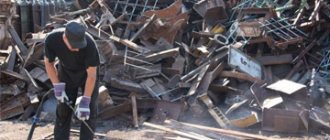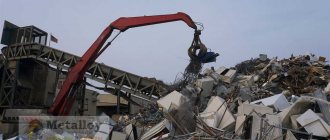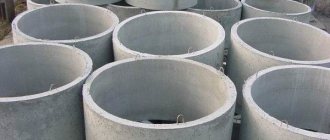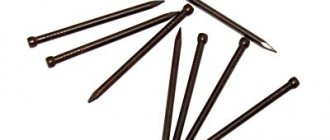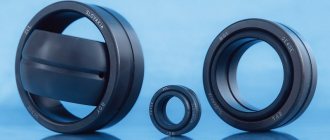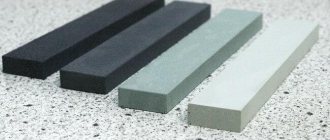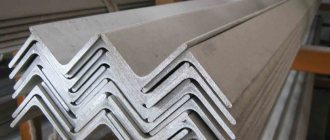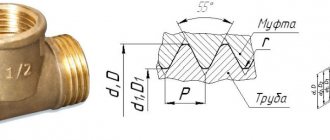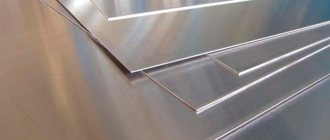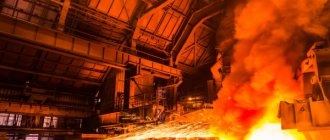Scrap and waste of ferrous and non-ferrous metals is actively used in metallurgy, since recycling technologies make it possible to conserve natural reserves and improve the environmental situation on our planet. An important point is the fact that the use of recycled materials does not affect the quality of the final product.
The procedure for delivering scrap metal to receiving and processing plants is regulated by a number of regulations. The list of requirements for the quality of delivered scrap includes an item on its sorting, designed to simplify further processing. It is not difficult to cope with the sorting procedure by studying the types of scrap metal.
Types of ferrous metal scrap: classification and GOSTs
In GOST 2787-75 there is a classification that separates the types of ferrous metal scrap and waste according to specified criteria.
Main types of ferrous metal
According to their qualitative characteristics, secondary ferrous metals are divided into 28 types.
The numbering depends on the class of metal waste:
- 1–16 – steel scrap;
- 16–24 – cast iron scrap;
- 25–28 - outside the classroom.
The latter includes scale obtained during the forging process of products and during the production of rolled products, additives from blast furnaces, and slag from welding.
Material categories and characteristics
Table of types of scrap metal:
| Category | Type of scrap | Note |
| 1 "A" | Lump trim ≥6 thick, weighing from 0.5–40, subject to remelting | Exception - wire |
| 2 "A" and "B" | Waste in pieces, ingots | Includes shaped rolled products, pipes and ingots written off as scrap |
| 3 "A" and "B" | Lump scrap (dimensions: 800*500*500 – no more) | |
| 4 "A" and "B", 5 "A" and "B" | Pieces (200*150*100), weighing 20, scrap | Wire and wire products are not allowed |
| 6 "A" and "B", 7 "A" and "B" | Chip briquettes and the chips themselves | |
| 8 "A" and "B" | Packages with dimensions 2000*1050*750 | |
| 9 "A" | High-density bags weighing ≥ 40 from recycled steel | |
| 10 "A" | Low density baling scrap metal | |
| 11 "A" and "B" | Rolled sheets and pipe products with metal thickness <6 | |
| 12 "A" | Waste from household activities, wire products | |
| 13 "A" and "B" | Steel ropes and wire bundles | |
| 14 "A", 15 "A" and "B" | Small-caliber shavings | Pieces are not included |
| 16 "A" and "B" | Wave-shaped steel filings | |
| 17 "A" and "B", 18 "A", 21 "A" | Cast iron ingots, molds and pallets | Max size ≤ 300 |
| 19 "A", 20 "A" and "B", 22 "A" | Cast iron scrap, pipes, billets | |
| 23 "A" and 24 "A" and "B" | Briquetted and homogeneous cast iron chips | |
| 25 "A" and "B" | Galvanized scrap metal | |
| 26 "A" and "B" | Slagged scrap | |
| 27 "A" | Scale formed during rolling and forging | Exception - piece trim |
| 28 "A" | Slag formed when Me is heated in furnaces |
Note: all parameters are indicated in millimeters and kilograms.
Scrap ferrous metals
Classification of secondary waste
The unified state classification of metals (secondary) looks like this:
- Classes. Depending on the quantitative carbon content.
- Categories. The division depends on the presence of alloying additives in the composition: A - carbon, B - alloyed.
- Kinds. From 1 to 28 – according to quality characteristics.
- Groups. 67 – depending on the content of alloying additives. The designation consists of: the letter “B” (placed first) and a number. The group code is represented by a two-digit number (from 0 to 06017).
Metal classification
Main divisions of ferrous metals
Material containing alloying components is regulated as category “B”, “A” includes carbon metals:
- unalloyed cast iron;
- steel;
- perch.
The letter designation “A” or “B” together with the number indicates the general designation of the waste type. For example, the entry 18 “A” means that this is secondary unalloyed cast iron. The name is also written according to the standard: 18 “A” - “Cast iron scrap and waste No. 2”.
Related video: The largest metal crusher in the world
vtorexpo.ru
Types of scrap metal, categories of ferrous metal scrap according to GOST
Types of ferrous metal scrap according to GOST:
• 1A: lump waste and scrap to be processed in melting units (except for wire products). The weight of the piece is 0.5-40 kg with a thickness of 6 mm.
• 2A, 2B: scrap metal in pieces, charge ingots subject to melting (wire does not belong to this type). The overall size of the piece is 60x35x25 cm. By agreement, we accept shaped rolled products, blooms, rejected ingots and billets, charge pieces of larger alloy steel. Thickness not less than 0.8 cm; for straight pieces, the permissible protrusion size is 10 cm; pipes with an outer diameter of up to 15 cm and a wall thickness of up to 0.8 mm. If the parameters of the pipes exceed the permissible limits, they must be cut or flattened. Each piece of scrap metal is from 2 kg.
• 3A, 3B: metal waste in pieces and scrap going for melting in units (with the exception of wire). Each piece should not exceed the size of 80x50x50 cm; for sheet recyclable materials in rolls, the parameters may be exceeded, but not more than 100 cm (by agreement). Thickness from 0.6 cm, from 0.4 cm there can be channels and I-beams with a total number of 20% of the lot. The outer diameter is up to 15 cm with a thickness of at least 0.6 cm. If the dimensions exceed the established ones, the products are deformed. For curved parts, the deflection is no more than 25 cm. The weight of each part is from 1 kg.
• 4A, 4B: small scrap generated in production (nuts, bolts, etc.) and suitable for melting in units. The wire cannot be used for melting. The maximum dimensions of a piece are 20x15x10 cm, thickness from 0.6 cm, weight 0.025 - 20 kg.
• 5A, 5B: oversized metal waste; pieces and scrap, scrap of steel, except wire. Scrap metal thickness from 0.6 cm.
• 6A, 6B: steel shavings in briquettes No. 1, without regulation on dimensions. Weight is 2-50 kg, with a minimum density of 5000 kg/m³, provided that the shavings that fall off during transportation are less than 3% of the total mass of recyclable materials.
• 7A, 7B: steel shavings in briquettes No. 2, regardless of dimensions, the condition is a weight of 2-20 kg and a density of 4500 kg/m³, the shavings shed upon delivery should not exceed 3%.
• 8A, 8B: lightweight clean steel waste in bags No. 1. Dimensions range from 200x105x75 cm, density from 2000 kg/m³, upon request, packages can have dimensions of 50x50x60 cm, or 60x60x80 cm, and weight from 40 kg.
• 9A, 9B: packages No. 2 made of lightweight high-density steel waste, with dimensions not exceeding 200x105x75 cm and with a density of 1800 kg/m³, weighing from 40 kg.
• 10A: scrap and steel waste in bags No. 3, with dimensions no more than 200x105x75 cm, density 1200 kg/m³ minimum, weighing from 40 kg.
• 11A, 11B: bagged scrap metal No. 1, waste of long metal, pipes, strips, clean sheets with a thickness of each piece of up to 0.6 cm and overall dimensions of 350x250x100 cm.
• 12A: baling scrap metal No. 2; industrial and household scrap, long sections, steel, sheet and strip waste, pipes, roofing, wire and wire products, with the exception of steel ropes. Pieces up to 0.6 cm thick and with dimensions 350x250x100cm.
• 13A, 13B: steel ropes and wire, rolled into coils, each with a diameter of no more than 100 cm and a length of up to 50 cm, weighing up to 20 kg.
• 14A, 14B: steel filings No. 1 without fragments of lump metal. The length of the coil is up to 5 cm, in the case of the presence of up to 10 cm, their number should be less than 3% of the total mass, cutting up to 0.025 kg.
• 15A, 15B: steel shavings No. 2 without creeper-shaped inclusions, tangles, pieces are not allowed. The length of the coil is up to 10 cm, the presence of coils up to 20 cm is permissible - maximum 3% of the mass, cutting up to 0.05 kg.
• 16A, 16B: vine-shaped shavings, intended for processing, without regulating dimensions.
• 17A, 17B: waste from cast iron and scrap No. 1 (elements of machine castings from cast iron), ingots. One part with dimensions up to 30 cm, weighing 0.5-20 kg.
• 18A: cast iron waste and scrap metal No. 2, elements of pallets. Part size up to 30 cm with weight 0.5-40 kg. According to the requirement, parts of a larger mass can be supplied, their share should not exceed 2%.
• 19A: waste iron and scrap No. 3, castings with high fluorine content, pipes, forging. The dimensions of each part are up to 30 cm, weighing 0.5-20 kg.
• 20A, 20B: oversized waste and cast iron No. 1 intended for processing, there are no restrictions on size and weight.
• 21A: cast iron category No. 2 and oversized in the form of molds and cast iron pallets, without size regulation.
• 22A: cast iron scrap No. 3 and waste of non-standard sizes with a high phosphorus content, castings, pipes of any size and weight.
• 23A: chips in briquettes without restrictions in size, weighing 2-20 kg, density from 5000 kg/m³, permissible percentage of crumbled chips 5%.
• 24A: pure cast iron shavings without inclusions of scrap or pieces.
• 25A, 25B: pieces of galvanized and enameled scrap, additives, cast iron crumbs, shavings, scrap with corrosive formations. The coil size is 25x25x25 cm, length no more than 10 cm.
• 26A, 26B: oversized additive, without size regulations, provided there are no non-ferrous metal inclusions.
• 27A: scale from production without trimmings and parts, sizes can be any.
• 28A: slag from furnaces without size restrictions.
www.chermetall-msk.ru
Why is scrap metal sorting needed?
Scrap metal serves as an important raw material for the metallurgical industry. Its sorting serves as an important processing step before the secondary raw materials are sent to the blast furnace.
The stringency of the requirements for the overall dimensions of scrap is explained by the peculiarities of transportation and subsequent processing. It is easy to transport batches of dimensional scrap in bulk in open freight cars and then send it for re-melting without additional cutting. This reduces cost and makes recycling easier.
An important point is the contamination of secondary raw materials. It should not contain:
- traces of corrosion;
- acid residues;
- signs of exposure to high temperatures.
Scrap metal prepared for processing must be clean, with a minimum percentage of contamination (up to 2%) in the form of sand, dust, and paint residues.
If all these conditions are met, scrap metal can be easily transported and processed without additional effort for cleaning and additional sorting.
Scrap classification - Reception of scrap ferrous and non-ferrous metals. Vtormet Company
Scrap classification
Scrap metal (metal scrap) is a general, collective name for various metal waste (deteriorated metal products), recycled or not recycled in the secondary metallurgical cycle. Most often, scrap metal refers to metal waste that is specially concentrated in designated areas for subsequent processing (disposal).
Types of scrap metal
Scrap metal is divided mainly according to the type of metal, which has a predominant percentage in the composition of scrap metal, or a predominant economic value when processing scrap metal.
Scrap and waste of non-ferrous metals and alloys are divided according to the names of the metals; according to physical characteristics - into classes; by chemical composition - into groups and grades of alloys; according to quality indicators - into varieties. Secondary ferrous metals are divided according to carbon content into two classes; according to the presence of alloying elements - into two categories; according to quality indicators - by 28 types; according to the content of alloying elements - into 67 groups. In economic activity, industry and trade, letter designations of types and groups of scrap metal, which are introduced by GOST, are widely used.
Ferrous scrap (ferrous metal scrap):
- Iron scrap: shavings, scale, casting waste, end-of-life products.
- Cast iron scrap: shavings, casting waste, etc.
- stainless steel scrap: metalworking waste, used products.
Non-ferrous scrap (non-ferrous metal scrap):
- Copper scrap: metalworking waste, and other waste.
- Scrap of copper alloys: waste from copper alloys (brass, bronze, tombac)
- Aluminum scrap: all kinds of scrap of aluminum and its alloys.
- Magnesium scrap: aircraft scrap metal.
- Titanium scrap: aircraft and ship scrap of titanium alloys.
- Lead scrap: battery and cable.
- Rare metal scrap: scrap of complex alloys and waste from high-tech industries.
- Semiconductor scrap: waste from the electronics industry.
Precious scrap (precious metal scrap):
- Gold scrap: used jewelry made from gold alloys, chemical equipment, catalysts.
- Silver scrap: used jewelry, silver-zinc batteries, catalysts, etc.
- Scrap of platinum metals: used jewelry, chemical equipment, crucibles, catalysts, electric heaters, etc.
Main categories of scrap metal
| Category | Description of scrap metal |
| 3A | Lump steel scrap - overall dimensions no more than 800*500*500 mm, piece weight no more than 600 kg and no less than 1 kg, pipes with a diameter of more than 200 mm must be flattened or cut along the generatrix. Metal thickness is at least 4 mm. |
| 5A | Oversized steel scrap, thickness from 4 mm, pipes up to 1.5 m long and more than 200 mm in diameter, not flattened or cut along the generatrix, structure weight up to 5 tons. |
| 12A | Steel scrap – metal thickness less than 4 mm. |
| 17A | Industrial cast iron scrap - size no more than 1500*500*500 mm |
| 19A | Scrap cast iron - size 1500*500*500 mm with a high phosphorus content, sanitary products (batteries, bathtubs, etc.) |
| 20A | Oversized cast iron scrap and industrial waste in the form of cast iron castings, molds and pallets, piece weight no more than 5 tons. |
| 22A | Oversized cast iron scrap and waste from plumbing production, etc. with increased and high phosphorus content. |
xn--24-dlcm8alooe.xn--p1ai
Classification by area of application
Often, when accepting for recycling, scrap metal is separated according to the area of use of the products to be disposed of. In this regard, it is customary to highlight:
- household scrap (various household appliances, devices, equipment and household items);
- depreciation waste (building structures and structures, entire cars, special equipment, river and sea vessels, diesel locomotives and railway equipment);
- military scrap (equipment and various military equipment legally decommissioned);
- lightweight scrap;
- lump (large, but within accepted standards);
- bagged (small waste properly compacted and prepared for melting);
- circulating scrap (rejects from factories and various industries);
- complex scrap (various products made of alloys and combined materials).
GOST scrap metal: scrap categories, classification, types
In this regard, it is very important, before making an application for transportation of ferrous metal from the territory, to familiarize yourself with GOST to determine its cost and profitability of delivery for processing. Even if you need to sell the car for scrap.
Recycled black scrap is classified into:
- steel;
- cast iron;
depending on the carbon content.
- Carbonaceous - A.
- Alloyed – B.
Based on the number of alloying elements, they are divided into 67 groups.
It is also possible to divide into 28 types based on quality indicators.
A table of classification of scrap metal by category can be found on our website, with its help you can determine:
- classes;
- categories;
- kinds;
as well as the designation and codes of steel.
| CATEGORIES | KINDS | TYPE NUMBER | GENERAL DESIGNATION |
| A | Steel scrap and waste No. 1 | 1 | 1A |
| A, B | Steel scrap and waste No. 2 | 2 | 2A, 2B |
| A, B | Steel scrap and waste No. 3 | 3 | FOR, ZB |
| A, B | Steel scrap and waste No. 4 | 4 | 4A, 4B |
| A, B | Oversized steel scrap and waste (for recycling) | 5 | 5A, 5B |
| A, B | Briquettes No. 1 from steel shavings | 6 | 6A, 6B |
| A, B | Briquettes No. 2 from steel shavings | 7 | 7A, 7B |
| A, B | Packages No. 1 | 8 | 8A, 8B |
| A | Packages No. 2 | 9 | 9A |
| A | Packages No. 3 | 10 | 10A |
| A, B | Scrap for baling No. 1 | 11 | 11A, 11B |
| A | Scrap for baling No. 2 | 12 | 12A |
| A, B | Steel ropes and wire | 13 | 13A, 13B |
| A | Steel filings No. 1 | 14 | 14A, 14B |
| A, B | Steel filings #2 | 15 | 15A, 15B |
| A, B | Vinyl steel filings (for recycling) | 16 | 16A, 16B |
| A, B | Cast iron scrap and waste No. 1 | 17 | 17A, 17B |
| A | Cast iron scrap and waste No. 2 | 18 | 18A |
| A | Cast iron scrap and waste No. 3 | 19 | 19A |
| A, B | Oversized cast iron scrap and waste No. 1 (for recycling) | 20 | 20A, 20B |
| A | Oversized cast iron scrap and waste No. 2 (for recycling) | 21 | 21 A |
| A | Oversized cast iron scrap and waste No. 3 (for recycling) | 22 | 22A |
| A | Briquettes made from cast iron shavings | 23 | 23A |
| A, B | Cast iron shavings | 24 | 24A, 24B |
| A, B | Domain additive | 25 | 25A, 25B |
| A, B | Oversized blast furnace additive (for processing) | 26 | 26A, 26B |
| A | Rolling and forging scale | 27 | 27A |
| A | Welding slag | 28 | 28A |
You will be interested in how ferrous and non-ferrous metal ores are mined
ecology-of.ru
How to determine the category of scrap metal?
Payment for an unsorted batch of scrap metal is usually set by the receiver at the level of the cheapest grade. Naturally, the maximum benefit from the delivery of recycled ferrous metal can be obtained by first preparing the scrap according to the established categories. The main types of ferrous metal waste are determined by GOST 2787-75 and are slightly modified at collection points, for example, for railway or automobile scrap.
Principles for constructing categories
The classification of recycled ferrous metals is carried out in accordance with GOST, based on the following characteristics of scrap metal: carbon content, quality grade of recyclable materials and the presence of alloying additives, their type, concentration. Since the most popular scrap metal is unalloyed iron, the category of waste is determined by two parameters: the type of iron and the quality (final form) of the scrap.
Based on carbon content, there are two classes: recycled steel (no more than 2.14%) and cast iron scrap. The quality classification is more diverse and includes 28 types. A characteristic feature of the quality distribution of ferrous metal scrap is its orderliness: the first 16 classes are reserved for steel waste.
The scrap metal category designation contains three components. The first component is the number of the type (quality) of recyclable materials, according to GOST. The following symbol corresponds to the presence of alloying impurities: A – carbon metals without additives, B – alloyed. The third parameter, auxiliary (not established by GOST), indicates a specific type of scrap metal, for example railway - railway.
This classification makes it easy to determine the type of metal:
- 1A – 16A – steel waste;
- 14A – 24A – cast iron scrap.
The remaining four classes are reserved for low-grade scrap metal and are not particularly popular.
Qualitative characteristics of waste
As stated earlier, high demand is exclusively for carbon scrap, without alloying additives. This is due to GOST requirements for the acceptance of alloyed scrap metal, which prohibit the presence in the batch of fragments with a different chemical composition (grade).
The determining element of the cost of ferrous metal scrap is its quality, which is classified into the following types:
- lump, including pipes;
- compressed bags made of lightweight structures;
- cast iron and steel shavings in bulk or briquetted form;
- wire waste;
- unsorted recyclables.
An additional characteristic of recycled cast iron is its phosphorus content. Scrap metal with a high concentration of this element is classified into separate categories. Considering the significant (double) difference in cost, shavings and wire are less popular and are not accepted by all points, leaving the palm to lump recyclables.
Most Common Categories of Ferrous Recycled Metal
Among steel scrap, categories are very popular, which, in principle, you need to distinguish between before handing over scrap metal:
- 3A – dimensional recyclables, with size restrictions of 800 (some collection points allow 1500) x 500 x 500 mm. The category includes pipes with a diameter of up to 150 mm (accepted in one piece). If the size is exceeded, the pipe must be opened at the seam or flattened.
Metal cut to size - a typical representative of category 3A
- 5A - oversized steel scrap, wall thickness must exceed 4 mm, solid pipes with a diameter of over 150 mm are allowed.
In the photo, scrap category 5A - any oversized steel scrap
- 12A – waste steel up to 4 mm thick.
The profiled sheet will be classified as category 12A - tin
Recycled steel has additional subcategories established at collection points (not included in GOST). For example, 3AP – railway scrap, including rails. Category 3AN concentrates large scissor waste. Oversized rail recyclables, including wheel sets, are classified as grade 5AP - by the way, one of the most expensive types of scrap metal. Scrap of motor vehicles, construction and agricultural equipment contains category 12AN. The equipment must be deregistered by the traffic police. This also includes broken household appliances: washing machines, refrigerators, etc.
The most common types of cast iron scrap metal are:
- 17A – cast iron scrap with size restrictions of 1500x500x500 mm
- 20A – oversized cast iron waste.
Oversized cast iron scrap
- 19A/22A – recycled cast iron with a high phosphorus content, usually heating batteries, plumbing products.
All scrap metal must be free of non-metallic inclusions, free of flammable substances, and not rusty.
xlom.ru
Admission conditions
The admission procedure is different for each company. Some organizations export non-ferrous scrap from 50 kg, others from 1 ton. Representatives visit the client to evaluate raw materials. There are companies that only accept refined metal. The price is affected by the type, weight, traces of chemical exposure, and contamination of waste.
The rules for accepting scrap apply to organizations working with metal. Scrap is accepted from citizens and legal entities if they have a document of the Russian Federation - passport, military ID. It is necessary to provide a certificate confirming the rights to the scrap.
There are age restrictions when handing over metal:
- Admission is prohibited for people under 14 years of age;
- from 14 to 16 years old - written parental permission is required.
At waste collection points, fill out a report indicating:
- Recipient.
- FULL NAME. the one who hands over the scrap.
- Seller's TIN.
- Bank details (for an entrepreneur or organization).
- Passport details.
- The brand and number of the transport on which the goods were delivered.
- Basis for waste disposal.
- Description of scrap.
- Weight in words.
The forms are filled out in two copies, which are recorded in the accounting book. The certificate is kept at the collection point for 5 years. When handing over recyclable materials, the seller is provided with a cash order. Pay sellers in cash.
Classification of ferrous metal scrap according to GOST 2787-75
In the general mass of structural materials, metal is still relevant. Massive cast metal structures are in demand; metal sheets are widely used in the production of various machinery, equipment and inventory. For a large country like Russia, it is economically beneficial to organize the recycling of scrap metal: equipment and equipment that have expired and become unusable, metal production waste. To sort scrap ferrous metals for recycling purposes, state classification standards are used, based on the physical, chemical and technical characteristics of the raw materials.
According to GOST 2787-75, secondary metal raw materials based on carbon content are divided into 2 large classes of scrap and waste: 1 - steel and 2 - cast iron.
It is known that in the production of steel, carbon and alloying components are used to improve its quality properties. Scrap and waste, depending on the additional components, are divided into two categories: A - carbon and B - alloying secondary metal.
The classification standard identifies 28 types of quality indicators and 67 groups based on the content of alloying components.
Recycled metal is sorted and encrypted according to GOST 2787-75 standards. Specialists in the acceptance of recyclable materials need to understand the content of the main positions of the classification of raw materials suitable for processing at metallurgical enterprises.
List of codes and names of ferrous scrap according to GOST:
| Code (class+category+type) | Summary of quality indicators for recyclable materials. |
| 1A | Scrap and waste lump metal for smelting furnaces. Wire is not allowed. There are restrictions on size and weight. |
| 2A and 2B | Scrap and waste lump metal for melting furnaces up to 60x35x25cm in size. Pieces with a coating of rust are not allowed. |
| 3A | Compressed pieces of pipes (D> 150mm), metal scraps of limited size and weight: no more than 150x50x50 cm, 1-600 kg, no less than 4 mm thick. |
| 3AB | Flattened tube-shaped (D> 150mm), other shaped pieces of metal limited in size and weight: no more than 150x50x50 cm 1-600 kg, thickness more than 8mm. |
| 3AP | Rail pieces of limited sizes up to 150x50x50 cm, bolts and other fastening components. |
| 3ABT | Flattened pieces of pipes (D> 150mm) or metal scraps of limited volume and weight: no more than 150x50x50 cm, 1-600 kg, no less than 20mm thick. |
| 4A and 4B | Small-sized scrap: washers, bolts, nuts and other parts suitable for melting. |
| 5A and 5B | Small pieces of slabs, sheet profiles, cut pipes suitable |
| 6A and 6B | Briquetted steel shavings No. 1 of a certain density and weight of at least 5 tons/m3 weighing at least 2 kilograms. |
| 7A and 7B | Briquettes of steel shavings No. 2 of a certain density and weight of at least 5 tons/m3 weighing at least 2 kg. |
| 8A and 8B | Packaged clean sheet steel waste No. 1 weighing no more than 40 kg. There are size restrictions. |
| 9A and 9B | Packaged clean sheet steel waste No. 2 weighing no more than 40 kg. There are size restrictions. |
| 10A | Bagged scrap No. 3 weighing no more than 40 kg. There are size restrictions. |
| 11A and 11B | High-quality packaged scrap: pipes, sheets, etc., weighing no more than 40 kg. |
| 12A | Packaged household and industrial scrap. |
| 13A and 13B | Cuttings of steel ropes, cables and wires, other fittings. Limitations: D |
| 5B22 | Manganese steel waste intended for remelting. |
Strict requirements are imposed on the quality of scrap intended for disposal, which is associated with the choice of processing method: foundry, smelting in open-hearth furnaces or remelting in oxygen converters or electric arc furnaces. And it is extremely important that scrap ferrous metals should not contain impurities of non-ferrous metals. After all, even minor impurities make such scrap unsuitable for further use. It is important for people whose occupation is involved in organizing the collection of recyclable materials for processing to understand the classification and codes of ferrous scrap and to have the skills to sort recycled metal according to GOST. The type of scrap metal directly determines its price upon receipt, and therefore the profitability of further recycling of scrap.
For Russia, organizing the collection of scrap ferrous metals for recycling purposes is a relevant and profitable business. The metallurgical industry widely uses recycled metal for processing, which consumes less electricity, saves iron ore reserves and significantly reduces harmful emissions into the atmosphere. About 60% of the needs for raw materials for the metallurgical industry are covered by scrap metal collected in accordance with strict regulations. Statistics show high incomes of enterprises in this area of economic activity.
Safety when handling non-ferrous scrap
When examining any batch of scrap, it is determined what percentage of substances that are harmful and life-threatening are contained in it. For this purpose, the level of radiation, explosion hazard, and the presence of harmful substances of chemical origin is determined.
All batches of scrap must be characterized by the presence of a certificate that corresponds to the GOST batch.
In accordance with the standards, the hazard class, temperature, type of substances, lower concentration level of fire propagation, fire hazard and other indicators are determined.
